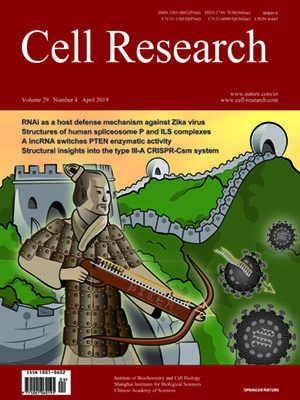
Volume 29, No 4, Apr 2019
ISSN: 1001-0602
EISSN: 1748-7838 2018
impact factor 17.848*
(Clarivate Analytics, 2019)
Volume 29 Issue 4, April 2019: 305-312 | Open Access
ORIGINAL ARTICLES
Coupling of ssRNA cleavage with DNase activity in type III-A CRISPR-Csm revealed by cryo-EM and biochemistry
Minghui Guo 1, Kaiming Zhang 2, Yuwei Zhu 1, Grigore D. Pintilie 2, Xiaoyu Guan 1, Shanshan Li 2, Michael F. Schmid 3, Zhuo Ma 1, Wah Chiu 2,3 and Zhiwei Huang 1
1 HIT Center for Life Sciences, School of Life Science and Technology, Harbin Institute of Technology, Harbin, Heilongjiang 150080, China; 2Departments of Bioengineering, and of Microbiology and Immunology, and James H. Clark Center, Stanford University, Stanford, CA 94305, USA and 3CryoEM and Bioimaging Division, SSRL, SLAC National Accelerator Laboratory, Stanford University, Menlo Park, CA 94025, USA
Correspondence: Wah Chiu (wahc@stanford.edu) or Zhiwei Huang (huangzhiwei@hit.edu.cn)These authors contributed equally: Minghui Guo, Kaiming Zhang
The type III CRISPR-Cas (clustered regularly interspaced short palindromic repeats-CRISPR-associated genes) systems are bacterially encoded adaptive immune systems for defense against invading nucleic acids. They accomplish this task through the coordinated cleavage of invading substrates of single-stranded RNA and DNA (ssDNA and ssRNA) by the Csm (type III-A) or Cmr (type III-B) effector complexes. The ssRNA is complementarily bound to the CRISPR RNA (crRNA). However, the structural basis for the DNase and RNase activation of the Csm nucleoprotein complex is largely unknown. Here we report cryo-EM structures of the Csm-crRNA complex, with or without target ssRNA, at near-atomic resolution. Our cryo-EM maps allow us to build atomic models of the key macromolecular components, including Cas10, Csm2, Csm3, Csm4, crRNA and the invading ssRNA. Our structure resolves unambiguously the stoichiometry and tertiary structures of the Csm protein complex and the interactions between protein components and the crRNA/ssRNA. Interestingly, the new atomic structures of the Csm proteins presented here are similar to those of previously known Csm proteins in other species despite their low sequence similarity. Our combined structural and biochemical data suggest that ssRNA cleavage is preferentially carried out near its 5’-end, that the extent of interactions among the ssRNA, crRNA and the protein components regulates the DNase activity of the Csm complex, and that the 3’ flanking sequence of ssRNA activates the Cas10 DNase activity allosterically.
https://doi.org/10.1038/s41422-019-0151-x
FULL TEXT | PDF
Browse 1184


